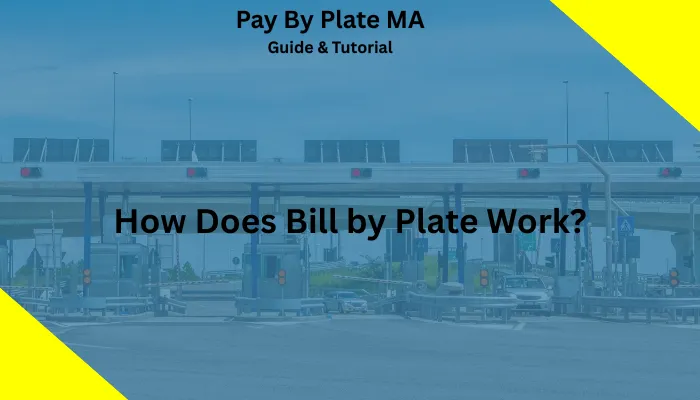I’ll never forget my first toll bill arriving in the mail, sparking curiosity about how they tracked my car. If you’ve driven through a toll like PayByPlate MA without a transponder, you’ve likely wondered the same. Bill by Plate simplifies paying tolls by capturing your license plate and sending you a bill.
In this guide, I’ll share how it works, its benefits, and tips to avoid issues. Join me as I break down this convenient system to help you navigate tolls with ease and confidence!

What Is Bill by Plate?
I’ve driven through countless tolls, and Bill by Plate always feels like magic when I don’t have a transponder. This system lets toll authorities charge you for using toll roads, bridges, or tunnels by capturing your vehicle’s license plate.
Instead of stopping at a booth or using a device like E-ZPass, cameras do the work, and you get a bill later. It’s a lifesaver for occasional toll users or those who forgot their transponder.
Why It Exists
When I first learned about Bill by Plate, I realized it solves a big problem. Not everyone has a toll pass, and cash booths are disappearing. This system ensures everyone pays their fair share without needing extra equipment.
- Convenience: No need to carry a transponder or stop at a booth.
- Fairness: Ensures all drivers pay for road usage.
- Efficiency: Speeds up traffic by removing manual payments.
I love how it simplifies things, but you’ll need to understand the process to avoid surprises. Let’s break it down.
How the System Captures Your Vehicle
I’ve always been fascinated by the tech behind tolls. Bill by Plate relies on cameras and license plate recognition to track your vehicle. Here’s how I’ve seen it work on toll roads:
Step-by-Step Process
- Cameras Snap Your Plate: As I drive through a toll point, high-tech cameras capture an image of my car’s license plate. These cameras work day or night, rain or shine.
- License Plate Recognition: The system reads the plate number using optical character recognition (OCR). I’ve noticed it’s super accurate, even with different plate designs.
- Vehicle Lookup: The system matches my plate to the registered owner using DMV records. This is how they know where to send my bill.
- Bill Generation: After confirming my details, the toll authority creates a bill and sends it to my address or email.
Technology Behind It
I’ve geeked out over the cameras before. They’re not just regular cameras—they’re designed for precision. They use infrared for night shots and can read plates at high speeds. Here’s a quick table of the tech involved:
| Component | What It Does |
|---|---|
| High-Resolution Cameras | Capture clear images of license plates in all conditions. |
| OCR Software | Converts the plate image into text for processing. |
| Database Integration | Links plate numbers to vehicle owner details. |
| Billing System | Generates and sends invoices based on toll usage. |
This tech makes the process seamless, but I always double-check my plate number on bills to avoid errors.
How Billing Works
I’ve received a few Bill by Plate invoices, and they’re straightforward once you know what to expect. How Does Bill by Plate Work? It’s all about getting that bill to you and making payment easy. Here’s what I’ve learned:
Receiving the Bill
After driving through a toll, I usually get a bill in the mail within a week or two. Some states, like Massachusetts, also offer online accounts for faster notifications. The bill includes:
- Toll Amount: The cost of each toll I passed through.
- Date and Time: When I used the toll road.
- Location: Which toll plaza or road was I on?
- Vehicle Info: My car’s make, model, and plate number.
Payment Options
I love the flexibility here. Most toll authorities give you several ways to pay:
- Online: I usually log into the toll authority’s website and pay with a card.
- Mail: You can send a check or money order with the bill stub.
- Phone: Some states let you call and pay with a card.
- In-Person: Certain locations accept cash or card payments.
Timing and Fees
I’ve learned to pay on time to avoid extra charges. Most bills give you 30 days, but late payments can add fees. For example:
| State | Payment Window | Late Fee |
|---|---|---|
| Massachusetts | 30 days | $10–$50 |
| New York | 30 days | $5–$25 |
| Florida | 30 days | $2.50–$25 |
Paying promptly saves money and keeps your account in good standing.
Benefits of Bill by Plate
I’ve used Bill by Plate for years, and it’s got some clear perks. How Does Bill by Plate Work? It makes tolls hassle-free, but there’s more to it. Here’s why I like it:
- No Equipment Needed: I don’t need a transponder, which is great for rental cars or occasional trips.
- Saves Time: No stopping at booths means faster travel.
- Accessible: Bills come to my mailbox or email, so I don’t miss them.
- Flexible Payments: I can choose how and when to pay.
It’s not perfect, though. Bills can take time to arrive, and you might forget about them. I set reminders to stay on top of payments.
Common Issues and How to Fix Them
I’ve hit a few snags with Bill by Plate, but they’re fixable. How Does Bill by Plate Work? Sometimes, it throws curveballs. Here’s what I’ve dealt with:
Incorrect Bills
Once, I got a bill for a car I didn’t own. It was a mix-up with a similar plate number. I called the toll authority, provided proof of my vehicle, and they fixed it.
Delayed Bills
Another time, a bill arrived late, and I nearly missed the payment window. I now check online accounts regularly to catch bills early.
Tips to Avoid Problems
- Verify Plate Info: Ensure your car’s registration is up to date.
- Check Bills Promptly: Review invoices for errors as soon as they arrive.
- Contact Support: If something’s wrong, call or email the toll authority right away.
Knowing these fixes keeps my toll experience smooth. Stay proactive to avoid these hiccups.
Comparing Bill by Plate to Transponders
I’ve used both Bill by Plate and transponders, so I can compare them. How Does Bill by Plate Work? It’s different from systems like E-ZPass. Here’s a breakdown:
| Feature | Bill by Plate | Transponder |
|---|---|---|
| Equipment Needed | None | Transponder device |
| Payment Timing | After travel (billed later) | Prepaid or auto-debited |
| Cost | Often higher toll rates | Discounted rates |
| Convenience | Great for occasional use | Better for frequent travelers |
I prefer Bill by Plate for rare toll trips, but transponders save money if you’re a regular.
Tips for Using Bill by Plate
I’ve got some tricks to make Bill by Plate work smoothly. How Does Bill by Plate Work? It’s easy if you follow these:
- Register Online: Create an account with your toll authority for faster bill access.
- Update Your Address: Ensure your DMV records are current to avoid lost bills.
- Pay Early: Settle bills before the due date to skip late fees.
- Keep Records: Save payment confirmations in case of disputes.
- Check Rental Cars: If you rent, ask about toll policies, as bills may go to the rental company.
These steps keep things stress-free and save you from headaches.
Conclusion
I’ve walked you through the Bill by Plate system, from cameras snapping your plate to paying your tolls on time. This method makes toll roads accessible without needing a transponder, perfect for occasional drivers like me.
By checking bills, updating your info, and paying promptly, you’ll breeze through the process. How Does Bill by Plate Work? It’s a simple, tech-driven solution that keeps you moving. Next time you hit a toll, you’ll feel confident knowing exactly how it all works. Safe travels and happy driving!
